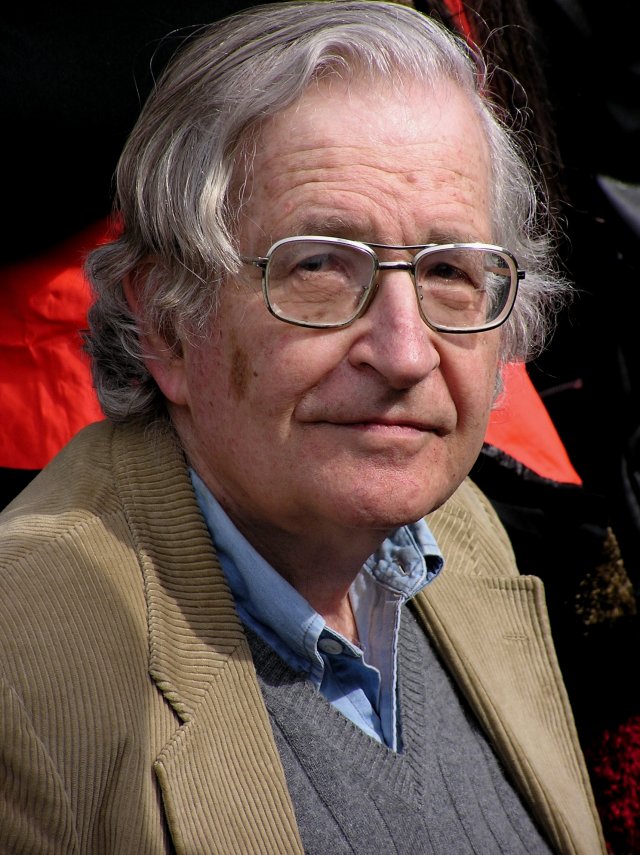
Who Rules The World?
By Noam Chomsky
Hamish Hamilton, 2016
Noam Chomsky, who turns 88 this month, revolutionised the study of linguistics in the second half of the 20th century, starting with books like Syntactic Structures (1957) and Aspects of the Theory of Syntax (1965). He remains professor emeritus at the Massachussetts Institute of Technology.
Chomsky’s many books and articles on theoretical linguistics are generally of a technical and demanding nature, but his political writings are written in a clear, direct and highly accessible style. His latest book, Who Rules The World?, is no different.
Consisting of 23 brief but meticulously researched chapters, he lucidly demonstrates that the world portrayed in the mainstream corporate media is usually the inverse of the truth.
Interestingly, at a number of points in the book, Chomsky invokes the 18th century founder of political economy, Adam Smith, a figure often held to have laid the theoretical foundations for free-market capitalism. Chomsky reminds us that for Smith, the “masters of mankind” were the “manufacturers and merchants” of his time.
Far from giving them unqualified support, Smith accused them of following the “vile” maxim, “All for ourselves and nothing for other people”, and described the consequences of their rule as “grievous” and involving “savage injustice”.
For Chomsky, the contemporary equivalents of Smith’s “masters of mankind” consist of multinational conglomerates protected by state power, the gargantuan and predatory institutions of international finance capital, and the elite figures who are their political representatives.
The “class conscious business world” and the corporate sector are the “primary domestic constituency of governments”. Chomsky does a great job in exposing the myths promulgated by the corporate media about the activities of the latter-day masters of mankind.
In his short chapter “One Day in the Life of a Reader of the New York Times” he takes a single edition — April 6, 2015 – and exposes lies and distortions relating to the US’s intensive bombing of northern Laos during the Vietnam War in 1969.
What was in fact the savage destruction of a defenceless peasant society, an act described even by the US deputy chief of mission Montreagle Stearns in terms suggesting that there was no genuine military rationale, becomes, in the words of the NYT reporter, a mission targeting North Vietnamese troops and their Laotian Communist allies.
Chomsky describes this as a “colossal lie in the service of the state”. He goes on to show how the NYT coverage of Obama’s restablishment of diplomatic relations with Cuba and of the Iran nuclear deal are equally misleading.
One of the great benefits of reading a book by Chomsky is that you become much more self-aware when reading the mainstream media. For example, as I write this, the NYT has just published an obituary of Fidel Castro, the recently deceased leader of the Cuban revolution.
According to the opening paragraph of the NYT obituary, Cuba “brought the Cold War to the western hemisphere in 1959” and “pushed the world to the brink of nuclear disaster”. Chomsky’s chapter “The Week The World Stood Still” gives you everything you need to see that this is another “colossal lie”.
Chomsky outlines how the John F. Kennedy administration, following the failure of the attempted “Bay of Pigs” invasion in 1961, had subjected Cuba to a “murderous and destructive terrorist campaign”. He shows how US policy towards Cuba envisaged “decisive US military intervention” applying the coup de grace to Castro’s revolutionary government after repeated paramilitary operations, economic warfare and sabotage.
The Soviet leader Nikita Khruschev’s deployment of missiles in Cuba in 1962 was a defensive move intended to protect the Soviet Union’s Cuban ally from further attack and invasion. In the light of Kennedy’s rejection of Russian offers to end the nuclear stand-off, only Khruschev’s sane decision to remove the missiles in late October 1962 averted catastrophe.
Remarkably, only weeks after the stand-off on November 8, 1962, “a covert action sabotage team from the United States successfully blew up a Cuban industrial facility”. The Cuban government said 400 Cuban workers were killed.
The world was indeed pushed close to nuclear catastrophe in October 1962, as US destroyers dropped depth charges on Soviet nuclear-armed submarines and the “secret doomsday plan to ensure the survival of the US government” went into effect in Washington. But contrary to the NYT, this was a result of Kennedy’s aggressive policy towards Cuba, not something of Cuba’s doing.
Chomsky’s book also contains penetrating discussions of Western policy towards Iran, the decline of US power, climate change, Israel-Palestine and the Oslo Accords, the Trans-Pacific Partnership (which Chomsky suggests should actually be described as an “investor-rights agreement”), the enlargement of NATO in Eastern Europe, the ever-present danger of nuclear war, Kennedy’s role in the Vietnam War, and much more besides.
There is also an inspirational chapter on the history of the once powerful and influential labour movement in the US.
Who Rules The World? was published a few months before the November US presidential election, but Chomsky is clear in identifying the Republican Party as “a real danger to decent human survival”. He identifies it as a party that, in its current form, appeals to people whose grievances are genuine but who are gravely mistaken about the causes of those grievances.
Those seeking to understand political systems in which large numbers of voters are “easy prey to demagogues” will find much illumination in Chomsky’s book: it will be indispensable reading for anyone seeking to understand events as they unfold in the new world of Brexit and Trump.